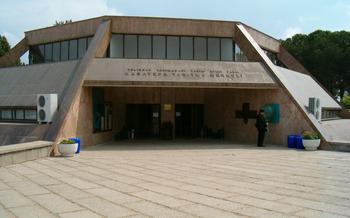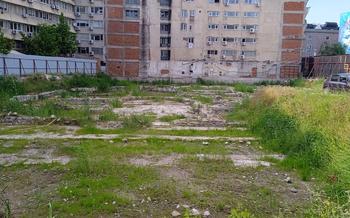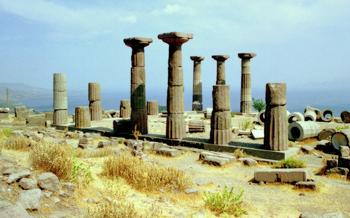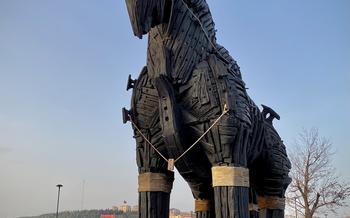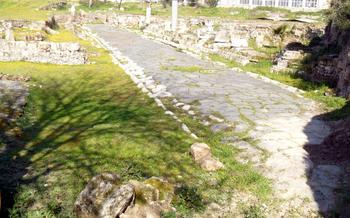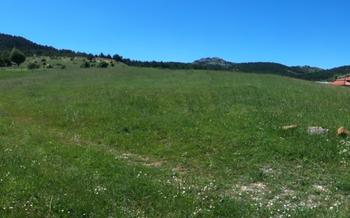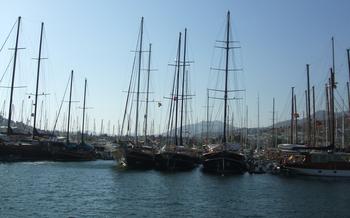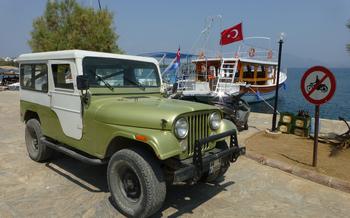
Tekirbahçe Archeology Park
- History of Tekirbahçe Archeology Park
- Getting to Tekirbahçe Archeology Park
- Entrance Fees and Hours of Operation
- Exploring the Tekirbahçe Archeology Park
- The Temple of Athena
- The Agora
- The Necropolis
- The Roman Theater
- The Byzantine Church
- The Medieval Walls
- The Olive Press
- The Museum of Tekirbahçe
- Local Cuisine and Restaurants
- Accommodation Options Near Tekirbahçe
History of Tekirbahçe Archeology Park
The Tekirbahçe Archeology Park is home to the ancient city of Assos, which was founded in the 7th century BC by Aeolian colonists from Lesbos. The city flourished as a major port and trading center, and was home to a diverse population of Greeks, Romans, Byzantines, and Ottomans.
In the 19th century, the site was excavated by French archaeologists who uncovered a wealth of artifacts, including sculptures, pottery, and inscriptions. These findings shed light on the history and culture of Assos, and helped to establish the site as one of the most important archaeological sites in Turkey.
Among the most significant archaeological findings at Tekirbahçe are the remains of the Temple of Athena, the Agora, the Necropolis, the Roman Theater, and the Byzantine Church. These structures provide a glimpse into the daily life and religious practices of the ancient inhabitants of Assos.
Getting to Tekirbahçe Archeology Park
Tekirbahçe Archeology Park is located in the Çanakkale province of Turkey, on the western coast of the country. It is situated in the small town of Tekirbahçe, approximately 35 kilometers south of the city of Çanakkale.
To get to Tekirbahçe Archeology Park, you can take a bus or drive your own car. There are several bus companies that operate services between Çanakkale and Tekirbahçe, and the journey takes about an hour. If you are driving, you can take the D550 highway south from Çanakkale and follow the signs to Tekirbahçe.
Once you arrive in Tekirbahçe, you can easily reach the Archeology Park on foot or by taxi. It is located just a few minutes' walk from the town center and is well-signposted. There is also a free parking lot available for visitors.
Entrance Fees and Hours of Operation
Admission Prices:
- Adults: 100 TL
- Students: 50 TL
- Children under 12: Free
Discounts:
- Groups of 10 or more: 10% discount
- Seniors over 65: 20% discount
- Disabled individuals: Free
Hours of Operation:
- Summer (April 1 - October 31): 9:00 AM - 7:00 PM
- Winter (November 1 - March 31): 9:00 AM - 5:00 PM
Insider Tip:
- Visit early in the morning or late in the afternoon: to avoid the crowds and enjoy a more peaceful experience.
Exploring the Tekirbahçe Archeology Park
The Tekirbahçe Archeology Park is a vast and sprawling site, encompassing a diverse range of ruins and artifacts from different historical periods. While it is impossible to see everything in a single visit, there are several must-see ruins and hidden gems that should not be missed.
Among the must-see ruins are the Temple of Athena, the Agora, the Necropolis, and the Roman Theater. These structures offer a glimpse into the civic, religious, and cultural life of ancient Assos. The Temple of Athena, perched atop a hill, is a particularly impressive sight, with its well-preserved columns and intricate carvings. The Agora, once the bustling marketplace of the city, is now a tranquil space where visitors can imagine the lively atmosphere of bygone days. The Necropolis, with its varied and well-preserved tombs, provides a glimpse into the funerary practices of ancient Assos.
In addition to these major ruins, there are numerous smaller structures and artifacts scattered throughout the park that are worth exploring. These include the Byzantine Church, with its colorful mosaics, the Medieval Walls, which once protected the city from invaders, and the Olive Press, which provides insight into the ancient olive cultivation and oil production in the region.
The Temple of Athena
The Temple of Athena is undoubtedly the most impressive and iconic structure within the Tekirbahçe Archeology Park. Built in the 6th century BC, this Doric-style temple was dedicated to the Greek goddess Athena, who was revered as the protector of the city. The temple's grand dimensions, intricate details, and well-preserved condition make it a testament to the architectural prowess of the ancient Greeks.
The temple is situated atop a hill, offering breathtaking views of the surrounding landscape. Its massive columns, finely carved pediments, and delicate friezes showcase the exceptional craftsmanship of the ancient builders. While the temple has undergone significant restoration efforts, it retains its original grandeur and serves as a symbol of Assos' rich cultural heritage.
Visitors can marvel at the temple's imposing facade, which features a pronaos (porch) supported by six Doric columns. The interior of the temple, though no longer adorned with its original statues, exudes a sense of awe and reverence. The sacred atmosphere of this ancient place of worship transports visitors back in time, allowing them to connect with the spiritual beliefs and practices of the ancient Greeks.
The Temple of Athena stands as a symbol of the enduring legacy of ancient Assos. Its remarkable preservation offers a glimpse into the architectural achievements, religious beliefs, and cultural traditions of this once-thriving city.
The Agora
The agora, or marketplace, was a crucial part of ancient Assos, serving as the economic and social hub of the city. Located in the heart of the city, it was a bustling center of activity where people gathered to buy and sell goods, exchange news and ideas, and conduct business.
The agora in Tekirbahçe Archeology Park is a large, open square surrounded by shops, stoas (covered walkways), and other public buildings. The stoas provided shelter from the sun and rain, and they were lined with shops selling a variety of goods, including food, clothing, pottery, and tools. In the center of the agora was a large fountain, which provided water for drinking and washing.
The agora was also the site of political and religious gatherings. The bouleuterion, or council chamber, was located in the agora, and it was here that the city's leaders met to discuss and decide on important matters. The agora was also the site of religious ceremonies and festivals, and it was here that people came to worship the gods and goddesses.
The agora in Tekirbahçe Archeology Park is a well-preserved example of an ancient Greek marketplace. It is a fascinating place to visit, and it provides a glimpse into the everyday life of the people who lived in Assos over 2,000 years ago.
The Necropolis
Located to the east of the ancient city, the necropolis, or cemetery, of Assos is a fascinating glimpse into the burial customs and beliefs of the ancient Greeks. Spread over a vast area, the necropolis contains hundreds of tombs, ranging from simple rock-cut graves to elaborate family mausoleums.
The most common type of tomb in the necropolis is the rock-cut tomb. These tombs were typically carved into the soft tufa rock of the area and consisted of a single chamber, where the deceased was laid to rest. Some of these tombs were decorated with simple carvings or inscriptions, while others were left plain.
More elaborate tombs, such as the family mausoleums, were typically built above ground and constructed from stone or brick. These tombs often had multiple chambers and were decorated with intricate carvings and sculptures. Some of the most impressive mausoleums in the necropolis belonged to wealthy and influential families of Assos.
The necropolis at Assos is a valuable source of information about the ancient Greek burial customs and beliefs. The variety of tombs found in the necropolis reflects the social and economic diversity of the city's population. The necropolis is also a reminder of the rich cultural heritage of Assos, which was once a thriving center of ancient Greek culture and civilization.
The Roman Theater
With a seating capacity of over 2,500, the Roman Theater is one of the most impressive structures in Tekirbahçe Archeology Park. Built in the 2nd century AD, it was used for theatrical performances, musical concerts, and public gatherings. The theater's acoustics are remarkably well-preserved, allowing visitors to experience the same auditory clarity that audiences enjoyed centuries ago.
The theater is constructed from local stone and features a semi-circular auditorium with tiered seating. The stage area is adorned with intricate carvings and statues, depicting scenes from Greek mythology and Roman history. The theater also boasts a sophisticated drainage system, which ensured that rainwater was effectively channeled away from the seating area.
Throughout its history, the Roman Theater has hosted a variety of events, including plays, comedies, and musical performances. It was also used for political speeches and public announcements. Today, the theater stands as a testament to the cultural and artistic achievements of the ancient Romans. Visitors can explore the theater's ruins, admire its architectural features, and imagine the vibrant atmosphere that once filled this ancient performance space.
The Byzantine Church
The Byzantine Church, located in the heart of the Tekirbahçe Archeology Park, stands as a testament to the region's rich religious history. Constructed during the Byzantine era, the church served as a sacred gathering place for the local Christian community. Its impressive size and elaborate design reflect the importance of Christianity in the region during that time.
The Byzantine Church showcases remarkable architectural features that blend Roman and Eastern influences. The church boasts a spacious nave, intricate stone carvings, and a well-preserved apse, the semi-circular recess that housed the altar. The walls were once adorned with vibrant frescoes and mosaics, depicting biblical scenes and figures, which have faded over time but still hint at their former glory.
Despite the passage of time, the Byzantine Church retains its spiritual essence and invites visitors to contemplate its historical significance. It serves as a reminder of the diverse religious traditions that have shaped the region and offers a glimpse into the lives and beliefs of the Byzantine people who once worshipped within its walls.
The Medieval Walls
The Medieval Walls of Tekirbahçe Archeology Park are a testament to the city's rich and varied history. Constructed during the Byzantine period, these walls were designed to protect the ancient city from invasion and attack.
The walls were built using a combination of stone and brick, and they feature a number of towers and gates. The main gate, known as the Gate of the Cross, is particularly impressive, with its elaborate carvings and decorations.
The walls were largely destroyed during the Ottoman period, but significant sections have been restored in recent years. Today, visitors can walk along the walls and enjoy stunning views of the surrounding countryside.
The Medieval Walls of Tekirbahçe Archeology Park are a reminder of the city's long and tumultuous history. They are a testament to the ingenuity and resilience of the people who lived here and are a must-see for any visitor to the park.
The Olive Press
The Tekirbahçe Archeology Park also houses the remains of an ancient olive press, a testament to the region's long and rich history of olive cultivation. While the exact date of its construction is unknown, the olive press is believed to have been in operation during the Roman period. This discovery provides valuable insights into the agricultural practices and economic activities of the ancient city of Assos.
The olive press consists of a series of stone basins and channels used to crush olives and extract their oil. The olives were first placed in the largest basin and crushed using a heavy stone roller. The resulting paste was then transferred to smaller basins, where it was further crushed and mixed with water. The oil and water mixture was then poured into a settling tank, where the oil would rise to the surface and be skimmed off.
The olive press at Tekirbahçe Archeology Park is a tangible reminder of the importance of olive cultivation in the region. It also highlights the ingenuity and resourcefulness of the ancient people who lived in Assos, who were able to harness the power of nature to produce a valuable commodity that was essential to their daily lives.
The Museum of Tekirbahçe
The Museum of Tekirbahçe, located within the archaeological park, is a treasure trove of artifacts and information that shed light on the rich history and culture of Assos. Step inside to embark on a journey through time, as you explore the museum's carefully curated exhibits and interactive displays.
The museum's collection boasts a diverse array of artifacts, from ancient pottery and tools to intricate sculptures and inscriptions. Each piece tells a story, providing glimpses into the daily lives, beliefs, and artistic expressions of the people who once inhabited Assos.
Interactive displays bring the ancient city to life, allowing visitors to engage with the past in a hands-on manner. Touchscreens and multimedia presentations provide in-depth information about the archaeological site, its history, and the ongoing excavations.
The museum also offers educational programs and workshops, designed to engage visitors of all ages and backgrounds. These programs provide a deeper understanding of the ancient world, encouraging participants to connect with the past and appreciate the enduring legacy of Assos.
Local Cuisine and Restaurants
The culinary heritage of Çanakkale is a blend of Turkish and Mediterranean flavors, with a strong emphasis on fresh seafood and local produce. Visitors to Tekirbahçe Archeology Park can savor traditional Turkish dishes in the nearby town of Behramkale.
Must-Try Dishes
-
Çanakkale Köfte: These succulent meatballs, made with a blend of spices and herbs, are a local specialty and a must-try for meat lovers.
-
Balık Çorbası: This hearty fish soup, brimming with fresh seafood, is a local favorite, especially during the colder months.
-
Midye Dolma: Savory mussels, stuffed with a flavorful rice filling, are a popular street food and a delight for seafood enthusiasts.
-
Zeytinyağlı Yemekler: Dishes prepared with olive oil, such as stuffed grape leaves or zucchini, showcase the region's renowned olive oil production.
Recommended Restaurants
-
Behramkale Balıkçısı: This charming restaurant, located near the harbor, offers a wide variety of fresh seafood dishes, including grilled fish, calamari, and shrimp.
-
Mevlana Restaurant: For a taste of traditional Turkish cuisine, head to Mevlana Restaurant, which serves up delicious kebabs, pide, and gözleme.
-
Ege Hanım'ın Yeri: This cozy eatery is known for its home-style cooking and offers a range of local dishes, including the famous Çanakkale Köfte.
Tips for Dining Out
-
Embrace Meze Culture: Start your meal with a selection of meze, small plates of appetizers, to sample a variety of flavors and textures.
-
Try Local Olive Oil: Çanakkale is renowned for its olive oil production, so be sure to drizzle some on your dishes to enhance their flavor.
-
Respect Dining Etiquette: Remember to remove your shoes before entering a restaurant and wait to be seated by the staff.
Accommodation Options Near Tekirbahçe
Tekirbahçe offers a range of accommodation options to suit different budgets and preferences. From cozy guesthouses and charming bed and breakfasts to modern hotels with stunning views, there's something for everyone.
For a truly immersive experience, consider staying in a traditional Ottoman-style guesthouse. These charming lodgings often feature authentic architecture, intricate tilework, and warm hospitality. You'll feel like you've stepped back in time as you relax in your room or enjoy a delicious breakfast in the courtyard.
If you're looking for a more modern option, there are several hotels in the area that offer comfortable accommodations and amenities such as swimming pools, fitness centers, and restaurants. Many of these hotels are located near the beach, providing easy access to the stunning coastline.
For a budget-friendly option, there are a number of hostels and guesthouses that offer dorm-style accommodations. These are a great choice for solo travelers or groups of friends who are looking to save money on their stay.
No matter what your budget or preferences, you'll be able to find a comfortable and convenient place to stay near Tekirbahçe.
Here are a few recommended hotels and guesthouses:
- Assos Hotel: This charming hotel is located right on the beachfront, offering stunning views of the Aegean Sea. It features comfortable rooms, a swimming pool, and a restaurant serving delicious Turkish cuisine.
- Tekirbahçe Pansiyon: This cozy guesthouse is a great option for budget-minded travelers. It offers simple but comfortable rooms and a friendly atmosphere.
- Assos Antik Evler: For a truly unique experience, stay in one of these restored Ottoman-style houses. Each house is decorated with traditional furnishings and offers a glimpse into the area's rich history.
When booking your accommodation, be sure to do it in advance, especially during the peak season. This will ensure that you get the best rates and availability.
